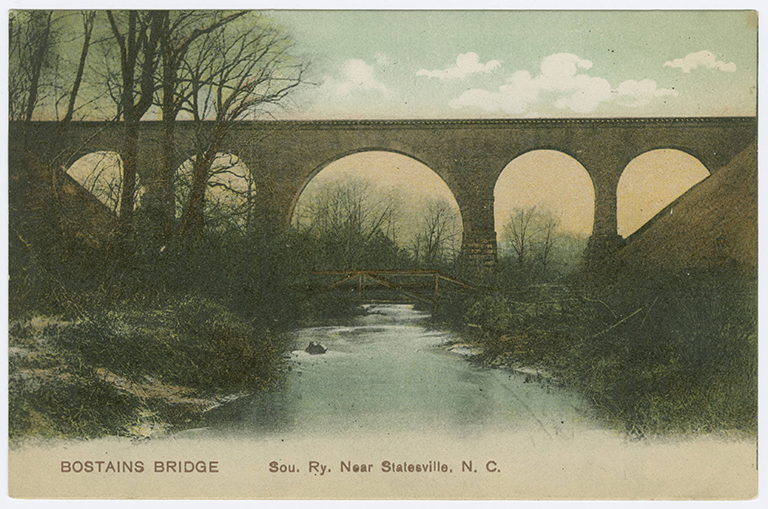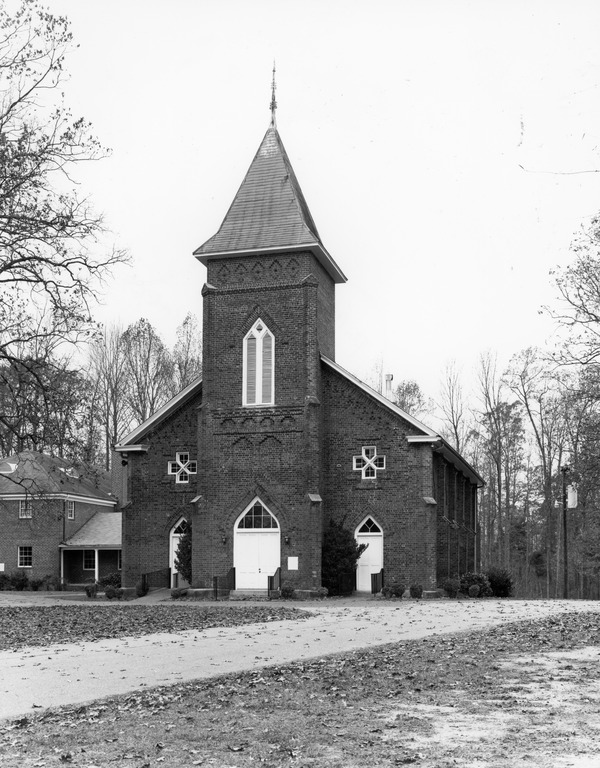Raeder, William (fl. 1850s)
Birthplace:
Germany
Residences:
- Rowan County, North Carolina
Trades:
- Architect
NC Work Locations:
Building Types:
Styles & Forms:
Gothic Revival
William Raeder (fl. 1850s), an architect and engineer of German background, worked in Salisbury and environs during the antebellum railroad-building boom. One of many skilled and mobile immigrant artisans who worked briefly in the state during antebellum era, he was employed by the Western North Carolina Railroad (WNCRR) as a draftsman in 1857 at $1,000 a year. The October 12, 1858, Salisbury Carolina Watchman listed him as a leading businessman, but by 1860 he had apparently left North Carolina.
Raeder’s background has not been established, but he was evidently from Germany, and was one of many American immigrants of that name. He advertised in Raleigh, Greensboro, and Charlotte papers as an architect and engineer who could supply plans and specifications for all types of buildings as well as railroad bridges. He gave as references the names of prominent leaders, including railroad men: J. W. Ellis and Charles Fisher of Salisbury, WNCRR engineer James C. Turner and treasurer R. F. Simonton; and C. P. Mendenhall, treasurer of the North Carolina Railroad. He may have done private work for some of these, but specific projects have not been established.
From his WNCRR railroad work, the great stone Third Creek Bridge (1858) is his chief monument. Raeder drew the plans; the contractor was Anderson Ellis of Davidson; and Robert Hendry “did the work.” The Salisbury newspaper called the 200-foot long bridge of five arches the “most extraordinary structure in the state”—”grand and imposing; combining great strength with a form sufficiently light and airy to give to the whole grace and beauty.” In Salisbury, where the railroad brought new prosperity and opportunities, Raeder joined with other new arrivals in various enterprises. With Danish-born mechanic Peter Frercks, he bought the old Boyden machine shop near the railroad, and in 1860 the firm was manufacturing equipment for nearby gold mines. He and Scots stonemason William Murdoch (also involved in railroad construction) formed the short-lived firm of Murdoch and Raeder. That firm built (and Raeder may have designed) the boldly detailed, Gothic Revival brick church, Thyatira Presbyterian Church (1858-1860) in Rowan County. The local newspaper reported that with the onset of the Civil War, Raeder “deserted to the North.”
Where William Raeder went after his brief stay in the Salisbury vicinity is unknown. However, it is possible that he was the Frederick William Raeder who became a prominent architect and engineer in post-Civil War St. Louis, Missouri. That man was described as an architect from Prussia, who had come to the United States about 1850, worked on the Crystal Palace in New York, and then on railroad projects around the country before settling in St. Louis. Frederick William Raeder became known in St. Louis for his iron-fronted buildings and his railroad and bridge building. He also established the department of building and architecture at Washington University in the 1880s.
- James Brawley files, Salisbury Public Library, Salisbury, North Carolina.
- Carolina Watchman, Oct. 12, 1858.
- Davyd Foard Hood, The Architecture of Rowan County North Carolina: A Catalogue and History of Surviving 18th, 19th, and Early 20th Century Structures (1983).
Third Creek Bridge
Contributors:Anderson Ellis, contractor; Robert Hendry, stonemason; William Raeder, engineerVariant Name(s):Bostian’s Bridge
Dates:1857
Location:Statesville, Iredell CountyStreet Address:Statesville vicinity, NC
Status:Standing
Type:Transportation
Note:The magnificent railroad bridge, known initially as the Third Creek Viaduct and later as Bostian’s Bridge, was the site of a disastrous and famous train crash in 1891.
Thyatira Presbyterian Church
Contributors:William Murdoch, builder; William Raeder, architectDates:1860
Location:Mill Bridge, Rowan CountyStreet Address:SR 1737, Mill Bridge vicinity, NC
Status:Standing
Type:Religious
Images Published In:Catherine W. Bishir and Michael T. Southern, A Guide to the Historic Architecture of Piedmont North Carolina (2003).
Davyd Foard Hood, The Architecture of Rowan County North Carolina: A Catalogue and History of Surviving 18th, 19th, and Early 20th Century Structures (1983).


